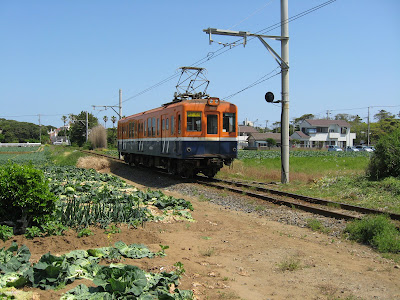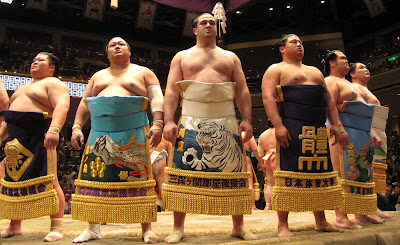Eeeew, Walmart is somehow affiliated with my local grocery store.
Saturday, May 30, 2009
Thursday, May 21, 2009
Inubo-zaki
 Itsumi and I took an overnight trip to Inubo-zaki, the eastern-most point on Japan's main islands. To get there we took several trains, ending on this tiny one-car train, a one-man operation. Some of the stations where this train stopped did not even have a ticket taker, and instead the driver took the fare.
Itsumi and I took an overnight trip to Inubo-zaki, the eastern-most point on Japan's main islands. To get there we took several trains, ending on this tiny one-car train, a one-man operation. Some of the stations where this train stopped did not even have a ticket taker, and instead the driver took the fare. We got off at Inubo-zaki, a small and rustic-looking station that would look more appropriate in South America rather than in Japan.
We got off at Inubo-zaki, a small and rustic-looking station that would look more appropriate in South America rather than in Japan. We checked into our ryokan, or traditional hotel, and penguins greeted us at the door! I think they are part of a cooperative project with the marine park next door.
We checked into our ryokan, or traditional hotel, and penguins greeted us at the door! I think they are part of a cooperative project with the marine park next door. Our hotel was right above the lighthouse, on the eastern-most point of Inubo-zaki. From here, you can see 330 degrees of ocean, and only 30 degrees of land.
Our hotel was right above the lighthouse, on the eastern-most point of Inubo-zaki. From here, you can see 330 degrees of ocean, and only 30 degrees of land. We took an evening walk on the beach before soaking in the hotel's hot springs.
We took an evening walk on the beach before soaking in the hotel's hot springs. On the beach we found a washed-up tire, covered with living baby shellfish! I don't think they survived though, because they had washed up in the tide.
On the beach we found a washed-up tire, covered with living baby shellfish! I don't think they survived though, because they had washed up in the tide. The sand made beautiful patterns on the beach.
The sand made beautiful patterns on the beach. We got up at 4:30 a.m. to watch the sunrise over this eastern-most point. After New Zealand and Australia, it is one of the first sunrises in the world. It was beautiful! I took these pictures from the terrace of our hotel.
We got up at 4:30 a.m. to watch the sunrise over this eastern-most point. After New Zealand and Australia, it is one of the first sunrises in the world. It was beautiful! I took these pictures from the terrace of our hotel. Inubo-zaki seemed to be a bit warmer than Tokyo, with palm trees and these cacti, which remind me of the prickly pear cactus from the American Southwest and Mexico.
Inubo-zaki seemed to be a bit warmer than Tokyo, with palm trees and these cacti, which remind me of the prickly pear cactus from the American Southwest and Mexico.
 Below are carp-shaped flags in honor of Children's Day, celebrated on May 5 in Japan.
Below are carp-shaped flags in honor of Children's Day, celebrated on May 5 in Japan. From our hotel, we took a hike to Inubo-zaki's observation tower, passing the tiny train as it trundled past vegetable fields.
From our hotel, we took a hike to Inubo-zaki's observation tower, passing the tiny train as it trundled past vegetable fields. 

 We saw some farmland from the observation tower, but mostly we saw 330 degrees of Pacific Ocean!
We saw some farmland from the observation tower, but mostly we saw 330 degrees of Pacific Ocean! And a wind farm
And a wind farm And ocean
And ocean From here it is possible to see a mountain in the Phillippines, using a telescope. We couldn't see it, but in the photo you can read the katakana word for Phillippines, which is pronounced hu-i-li-pi-n. (I can read this now!)
From here it is possible to see a mountain in the Phillippines, using a telescope. We couldn't see it, but in the photo you can read the katakana word for Phillippines, which is pronounced hu-i-li-pi-n. (I can read this now!)Monday, May 18, 2009
Sumo

I went to a sumo (pronounced s'mo in Japanese) tournament yesterday, and I got a great seat! I paid for a cheap general admission ticket, but since it was a week day and I got there early I was able to sit in an unoccupied front row seat for most of the tournament.

I'm not big on sports, and I've never been to an American professional boxing or wrestling match, but I have to say that watching sumo was exciting, and not only because of the size of the wrestlers. Sumo originated more than 1500 years ago, as part of a harvest festival, but later became the national sport of Japan.

Today, the matches are decided really quickly, as soon as one of the wrestlers steps outside of the ring or touches the mat with any part of his body other than his feet. There are no weight limits in sumo, and the wrestlers are not matched for weight.

The day starts with the low-ranked or unranked wrestlers, but after lunch the higher ranked wrestlers come in during the entering the ring ceremony. They wear embroidered aprons that can cost $5,000 or even $10,000 each.

The higher-ranked matches last a little longer especially because of all of the maneuvering and stretching before each match.
 According to the brochure, this is the time when the wrestlers glare fiercely at each other, but compared to American wrestling that I've seen on TV I didn't think that their glare was that fierce in most cases.
According to the brochure, this is the time when the wrestlers glare fiercely at each other, but compared to American wrestling that I've seen on TV I didn't think that their glare was that fierce in most cases. 

Some of the sumo wrestlers, perhaps this one, have been recruited from other countries such as Bulgaria.
I was impressed that after each match the winner seemed to check to make sure that the loser was ok before returning to his side of the ring, and there was no taunting or cheering or shouting by the winner. The wrestlers just bowed to each other and left the ring.
The top wrestlers, or yokozuna, enter the ring wearing a massive braided hemp rope weighing up to 35 pounds tied in a bow at his back and ornamented in the front with zig-zag paper, a religious symbol in Japan.

Yokozuna are attended by other wrestlers, one bearing a sword, and they perform the dohyo-iri ceremony.

Before a match, each wrestler does a purification ceremony consisting of rinsing his mouth with water, wiping his body with a towel and throwing salt in the ring.

Sumo wrestlers wear a silk loincloth, approximately ten yards long and two feet wide. The loincloth is folded in six and then wrapped around the waist from four to seven times, depending on the girth of the wrestler. Many sumo moves involve grabbing an opponent's belt, but the wrestlers are not allowed to grab other parts of the loincloth. The high-ranked wrestlers wear a special topknot shaped like a gingko tree leaf.

Before and after the tournament, wrestlers wear kimonos and can be seen in the stadium and entering the building.

The referees, or gyoji, wear kimonos patterened after the samurai style from 800 years ago. Their black court hats are in the style of a traditional Shinto priest's hat. The lower-ranked gyoji are barefoot, but the higher ranked refs wear tabi socks.

Between matches, the water boy replenishes the salt basket, prepares the water and towels and helps sweep the ring.


At lunch time I tried a bowl of chanka nabe, the traditional food of sumo wrestlers.

The chanka tasted good and seemed pretty healthy, with lots of vegetables and just a bit of chicken. It doesn't seem like chanka would make you fat, but the key to sumo wrestlers' large physique is that they don't eat breakfast or lunch. They eat just one meal per day, dinner, and they go to bed immediately after eating. That way, the calories turn into fat while they sleep. Because they don't eat during the day they have a really low metabolism and don't process many calories during the day. Don't try this at home!
 Traditional Japanese seating at the sumo tournament
Traditional Japanese seating at the sumo tournamentMonday, May 11, 2009
Yoyogi Park
You never know what you will see in Yoyogi Park. I really like this guy's hair.

This Rockabilly group danced away a Sunday afternoon to hits like "Let's Go to the Hop." The shirt says "American Junior Bowling Congress."
 Rockabilly was really popular in Yoyogi Park in the 1980s, and the police actually shut it down for awhile because so many dancers were blocking the streets. Now there are just a couple of small groups who dance on Sundays.
Rockabilly was really popular in Yoyogi Park in the 1980s, and the police actually shut it down for awhile because so many dancers were blocking the streets. Now there are just a couple of small groups who dance on Sundays.

 This looks to be a father-daughter duo, complete with saddle shoes.
This looks to be a father-daughter duo, complete with saddle shoes.

 This is an all-male and rather tougher looking Rockabilly group. Some of these guys had tattoos, even one tattoo of Mexico's Virgin of Guadalupe! In Japan, tattoos are viewed as a sign of membership in the Japanese yakuza, or mafia. Many hot springs refuse to admit people with tattoos. But these guys were just having a fun time in the park.
This is an all-male and rather tougher looking Rockabilly group. Some of these guys had tattoos, even one tattoo of Mexico's Virgin of Guadalupe! In Japan, tattoos are viewed as a sign of membership in the Japanese yakuza, or mafia. Many hot springs refuse to admit people with tattoos. But these guys were just having a fun time in the park.

This Rockabilly group danced away a Sunday afternoon to hits like "Let's Go to the Hop." The shirt says "American Junior Bowling Congress."
 Rockabilly was really popular in Yoyogi Park in the 1980s, and the police actually shut it down for awhile because so many dancers were blocking the streets. Now there are just a couple of small groups who dance on Sundays.
Rockabilly was really popular in Yoyogi Park in the 1980s, and the police actually shut it down for awhile because so many dancers were blocking the streets. Now there are just a couple of small groups who dance on Sundays.
 This looks to be a father-daughter duo, complete with saddle shoes.
This looks to be a father-daughter duo, complete with saddle shoes.
 This is an all-male and rather tougher looking Rockabilly group. Some of these guys had tattoos, even one tattoo of Mexico's Virgin of Guadalupe! In Japan, tattoos are viewed as a sign of membership in the Japanese yakuza, or mafia. Many hot springs refuse to admit people with tattoos. But these guys were just having a fun time in the park.
This is an all-male and rather tougher looking Rockabilly group. Some of these guys had tattoos, even one tattoo of Mexico's Virgin of Guadalupe! In Japan, tattoos are viewed as a sign of membership in the Japanese yakuza, or mafia. Many hot springs refuse to admit people with tattoos. But these guys were just having a fun time in the park.
Subscribe to:
Comments (Atom)

 Walmart-brand disposable chopsticks.
Walmart-brand disposable chopsticks.














